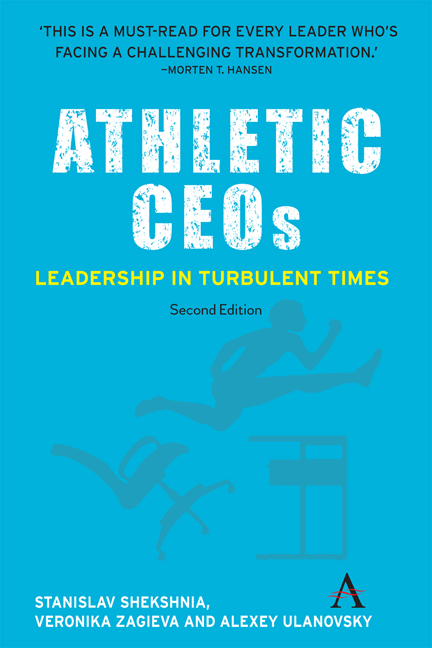Book contents
- Frontmatter
- Contents
- List of Illustrations
- Introduction to the Second Edition
- 1 Athletic Leadership Explained
- 2 The Agenda and Practices of Athletic Leaders
- 3 Effectiveness of Athletic Leadership: Outputs and Outcomes
- 4 Vitaly Saveliev: Passion and Innovation at the Old Airline
- 5 Eugene Kaspersky: Saving the World
- 6 Alexander Dyukov: Quiet Transformation of Gazprom Neft
- 7 Herman Gref at Sberbank: Entrepreneurship in the Least Likely Place
- 8 Athletic Leadership in Other Regions: Roger Agnelli, Dong Mingzhu and Jeff Bezos
- 9 Athletic Leadership for Non-Athletes
- Appendix: Research Methodology
- Index
3 - Effectiveness of Athletic Leadership: Outputs and Outcomes
Published online by Cambridge University Press: 04 October 2019
- Frontmatter
- Contents
- List of Illustrations
- Introduction to the Second Edition
- 1 Athletic Leadership Explained
- 2 The Agenda and Practices of Athletic Leaders
- 3 Effectiveness of Athletic Leadership: Outputs and Outcomes
- 4 Vitaly Saveliev: Passion and Innovation at the Old Airline
- 5 Eugene Kaspersky: Saving the World
- 6 Alexander Dyukov: Quiet Transformation of Gazprom Neft
- 7 Herman Gref at Sberbank: Entrepreneurship in the Least Likely Place
- 8 Athletic Leadership in Other Regions: Roger Agnelli, Dong Mingzhu and Jeff Bezos
- 9 Athletic Leadership for Non-Athletes
- Appendix: Research Methodology
- Index
Summary
I hated standing on that third-place podium. Hated it, hated it.
– Michael PhelpsMy father says that if I hit 2,500 balls each day, I'll hit 17,500 balls each week, and at the end of one year I'll have hit nearly one million balls. He believes in math. Numbers, he says, don't lie. A child who hits one million balls each year will be unbeatable.
– Andre AgassiLeadership is too complex a phenomenon to be measured easily. One very experienced CEO said that ‘you cannot seriously talk about a particular leader's effectiveness until after ten years after her departure’. Although we see the point, we cannot wait that long and would like to offer our view on the athletic leaders’ effectiveness in this chapter.
For many decades leadership effectiveness was equated with the business results of the organization being led. If your company had gained market share and was more profitable than the industry average, you were doing great as a leader. Today this approach looks simplistic and one-dimensional. Organizational performance is influenced by many factors, and some of them are beyond the leader's control. Current results are to a large extent determined by past decisions, while the decisions a CEO makes today will have an impact on the company's results for years to come. We therefore need to add a time horizon when measuring the leader's impact on business results. We also have to differentiate between current performance (results that have been achieved) and contribution to future performance, that is, the creation of a platform for sustainable organizational development. It is important to note that sometimes current performance will reduce an organization's ability to win in the long run and vice versa. Effective leaders balance short-and long-term perspectives.
As early as the 1950s, Philip Selznik argued that, while business performance is a very important outcome of a leader's work, the primary function of leadership is to infuse purpose and meaning into the lives of individuals. Since leadership is the process of achieving goals through the actions of other people, leaders – whether they like it or not – leave an impact on their followers. Leaders change how these people work, think and live, creating new meaning for them and (intentionally or not) teaching them new behaviours.
- Type
- Chapter
- Information
- Athletic CEOsLeadership in Turbulent Times, pp. 67 - 84Publisher: Anthem PressPrint publication year: 2019



